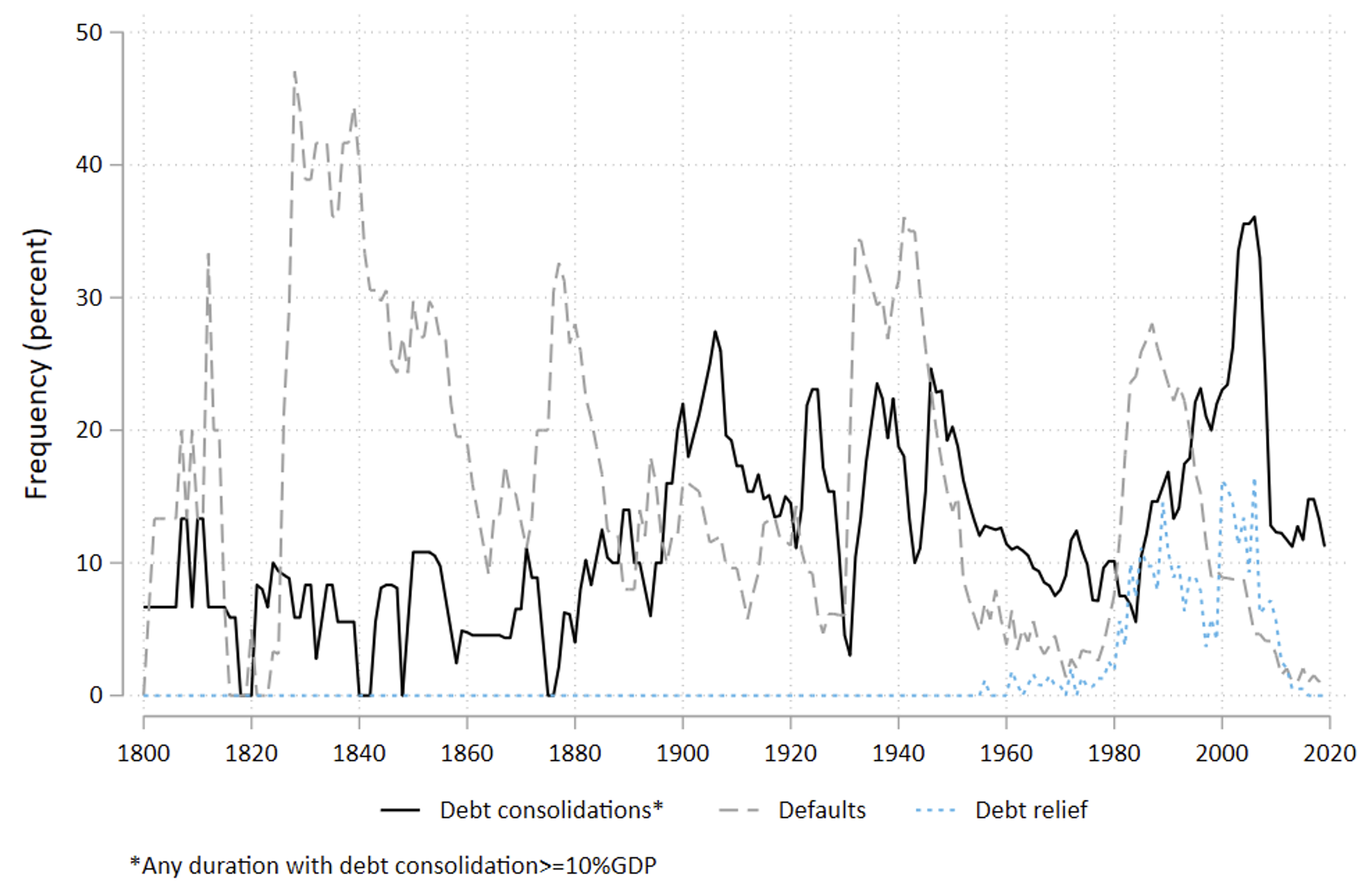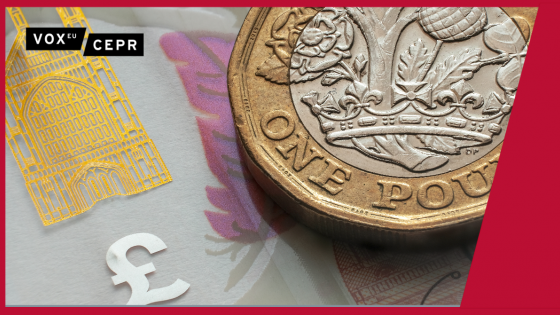Public debts soared in the wake of the global financial crisis and the COVID-19 pandemic, with gross debt levels rising by about 15% of world GDP on both occasions. At some point, governments will have to pivot toward debt consolidation. They will attempt to reduce debt-to-GDP ratios in order to prevent debt service costs from crowding out other public programmes and debt overhangs from becoming a burden on private investment. They will take steps to enhance and restore their capacity to borrow in order to meet the next emergency.
In the past, some governments have relied on inflation to reduce and even liquidate heavy debts, Weimar Germany being a textbook example (Feldman 1997). Similarly, there is discussion currently of whether inflation will be part of the response to current debt problems (e.g. Goodhart and Pradhan 2020), though few would credit the likelihood of a Weimar-like scenario in the advanced countries.
What we do
In a recent paper (Eichengreen and Esteves 2022), we analyse the role of inflation in debt consolidations over the last 220 years. We build a database of historical debt consolidation episodes covering a maximum of 183 countries and apply an accounting framework to distinguish the role of inflation.
This is, to our knowledge, the first attempt to assemble a worldwide historical database of debt consolidations spanning such a long period, although it is preceded by important country studies (e.g. Hernandez de Cos et al. 2016 for Spain, Wickens 2022 for the UK), on which we build. It is similarly the first attempt to apply a framework explicitly distinguishing the role of inflation to a large debt-consolidation dataset.
We define debt consolidation in a number of different ways. At one extreme, we include episodes of any duration (one year or longer) over which the debt/GDP ratio fell by at least 10 percentage points. At the other, we include episodes lasting at least 10 years and involving a decline in debt/GDP of at least 15 percentage points. We allow for interruptions – periods when the ratio rose – so long as these were no more than two years in length. We identify as many as 283 debt consolidation episodes over two-plus centuries.
Consolidation episodes
Figure 1 shows a histogram of consolidation durations (in years). It spans the long 19th century (through 1913), the interwar period, the years from WWII to the Latin American debt crisis, and the subsequent period. In all four eras, the histogram is skewed to the right, with most episodes lasting fewer than 15 years, apart from some exceptionally long consolidations in the third period (1945–82).
Figure 1 Histogram of consolidation durations (in years)
In Figure 2 we show the frequency of debt consolidations over time (as a share of all corresponding country/year observations) juxtaposed with the frequency of debt defaults and episodes of debt relief. We see the familiar clustering of defaults around systemic financial crises in the 1830s, 1870s, 1930s, and the 1980s. Debt relief is concentrated in recent decades, reflecting the Heavily Indebted Poor Countries (HIPC) initiative of the 1990s and the Multilateral Debt Relief Initiative (MDRI) in the 2000s. In contrast, conventional debt consolidations tend to occur after wars or in periods of relative macroeconomic stability.
Two periods stand out. The first is the turn of the 20th century, when a long period of deflation gave way to inflation, due to a series of global gold discoveries, but inflation expectations and interest rates remained anchored by widespread adoption of the gold standard. The second is the recent decades, leading up to the global financial crisis. The extent of progress on debt consolidation in this period has not been fully appreciated, although there has been much discussion and analysis of a few prominent cases, such as the US under the Clinton administration and European countries seeking to meet the fiscal preconditions for euro area membership (Eichengreen et al. 2021). We refer to this set of consolidation episodes, which involved not only advanced countries but also emerging and developed nations since the late 1980s, as the ‘Great Consolidation’.
Figure 2 Frequency of debt consolidations (any duration) versus defaults and debt relief, 1800-2019
The role of inflation
We do not find a uniformly strong positive association between inflation and the frequency of debt consolidation. In general, we find that the connection between inflation and debt consolidations has varied over time.
Figure 3 summarises the evidence by plotting simultaneously the frequency of debt consolidations, median inflation among countries undergoing consolidations, and the share of these decompositions accounted for by inflation. The contribution of inflation to debt consolidation was greatest in the modestly inflationary post-WWII period 1945–82, when financial repression and relatively long maturities prevented interest rates from keeping up, and in the post-1982 period, over much of which inflation, while positive, was relatively low and stable and when interest rates again failed to keep up (price expectations being relatively well anchored). The contribution of inflation as a share of total debt consolidation was lower in the 1920s, when inflation was high and interest rates responded; in the 1930s, when inflation gave way to deflation; and in the pre-1913 period, when there was little overall change in the price level. Neither a stable monetary anchor (the gold standard) combined with deflation in the 1870s and 1880s nor the unstable dynamics of the interwar years provided a basis for eroding the debt stock through inflation. Instead, primary budget surpluses and economic growth were more important for bringing down debt ratios in these periods.
Figure 3 Debt consolidations versus inflation, by period
Even in episodes where inflation accounted for a significant fraction of observed debt consolidation, interest payments on new debt often rose to offset all or part of its contribution. This points to the importance of financial factors that condition the role of inflation, such as debt maturity, financial regulation or repression, monetary rules, and inflation expectations. In addition, there is a role for political economy, operating through the democratic accountability of governments, type of political regime, political ideology, and the autonomy of policymakers (Eichengreen and Panizza 2014). In our paper, we illustrate the importance of these factors in a number of country case studies.
Conclusion
Debt consolidations have tended to occur in periods of rising (generally, gradually rising) prices. For example, inflation accounted for a larger fraction of observed debt consolidation in the inflationary post-WWII period 1945–82 than in other earlier and later periods. But when inflation was high and persistent, interest payments often rose sufficiently to more than offset any positive contribution of inflation to debt reduction. Inflation contributed positively on net – in other words, once this interest-rate response is taken into account – in no more than half the large debt consolidations. Understanding why inflation contributed positively in these cases but not others directs attention to such factors as debt maturity, financial regulation, and expectations.
In 1919, Maynard Keynes wrote that “[b]y a continuing process of inflation, governments can confiscate, secretly and unobserved, an important part of the wealth of their citizens…As the inflation proceeds and the real value of the currency fluctuates … all permanent relations between debtors and creditors, which form the ultimate foundation of capitalism, become so utterly disordered as to be almost meaningless” (Keynes 1978: 148-49). Keynes was worried about the inflationary consequences of the monetization of military expenditures in the late stages of WWI. Even though some of the most emblematic debt extinctions through inflation followed the Great War, most famously of all the German hyperinflation of 1923, it is not the case that the bulk of the war debts was inflated away. Evidently, compelling narratives based on a small handful of notorious case studies can get ahead of facts.
References
Eichengreen, B and R Esteves (2022), “Up and Away? Inflation and Debt Consolidation in Historical Perspective,” CEPR Discussion Paper No. 17559.
Eichengreen, B and U Panizza (2014), “Can large primary surpluses solve Europe’s debt problem?”, VoxEU.org, 30 July.
Eichengreen, B, A El-Ganainy, R Esteves and K Mitchener (2021), In Defense of Public Debt, Oxford University Press.
Feldman, G (1997), The Great Disorder: Politics, Economics and Society in the German Inflation, 1914-1924, Oxford University Press.
Goodhart, C and M Pradhan (2020), “Future Imperfect after Coronavirus,” VoxEU.org, 27 March.
Hernández de Cos, P, S Hurtado, F Martí and J Pérez (2016), “Public Finances and Inflation: The Case of Spain,” Banco de España: Documentos Ocasionales No. 1606.
Keynes, J M (1978), The Economic Consequences of the Peace, Vol. 2 of E Johnson and D Moggridge (eds), The Collected Writings of John Maynard Keynes, Royal Economic Society.
Wickens, M (2022), “How Might the UK's Debt-GDP Ratio be Reduced? Evidence from the Last 120 Years”, CEPR Discussion Paper No. 17172.







